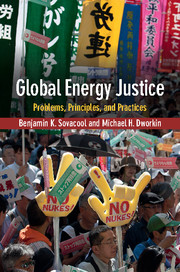Book contents
- Frontmatter
- Epigraph
- Dedication
- Contents
- Analytical table of contents
- List of figures
- List of tables
- Acknowledgements
- List of abbreviations
- 1 Introduction
- 2 The global energy system
- 3 Virtue and energy efficiency
- 4 Utility and energy externalities
- 5 Energy and human rights
- 6 Energy and due process
- 7 Energy poverty, access, and welfare
- 8 Energy subsidies and freedom
- 9 Energy resources and future generations
- 10 Fairness, responsibility, and climate change
- 11 The imperative of making just energy decisions
- Index
- References
7 - Energy poverty, access, and welfare
Published online by Cambridge University Press: 05 October 2014
- Frontmatter
- Epigraph
- Dedication
- Contents
- Analytical table of contents
- List of figures
- List of tables
- Acknowledgements
- List of abbreviations
- 1 Introduction
- 2 The global energy system
- 3 Virtue and energy efficiency
- 4 Utility and energy externalities
- 5 Energy and human rights
- 6 Energy and due process
- 7 Energy poverty, access, and welfare
- 8 Energy subsidies and freedom
- 9 Energy resources and future generations
- 10 Fairness, responsibility, and climate change
- 11 The imperative of making just energy decisions
- Index
- References
Summary
It starts as a good week. Despite the snow and cold, you celebrate your twenty-fifth birthday and first year on the job as the service engineer for an electric utility in Kazakhstan. You deposit a reasonable paycheck and are proud of bringing energy services to the households, enterprises, and industries that need it. This week, too, you have a new assignment: five houses within 10 miles of your service center have failed to pay their electric bills for the past two months. Your work orders are simple: disconnect those five homes from the electric grid.
How do you feel about this task? What do you ask yourself before you either implement the disconnection, or defer it? Does your company have any hard rules or soft policies to guide you? Does it matter whether a storm is coming in, or if a cold snap is expected? Or if you know the age, health, wealth, or merit of the people living in those homes? Does it matter if the cost of keeping “deadbeats” on the system will be paid by the utility’s investors, or by surcharges from other homeowners who do pay their bills on time?
- Type
- Chapter
- Information
- Global Energy JusticeProblems, Principles, and Practices, pp. 223 - 255Publisher: Cambridge University PressPrint publication year: 2014



